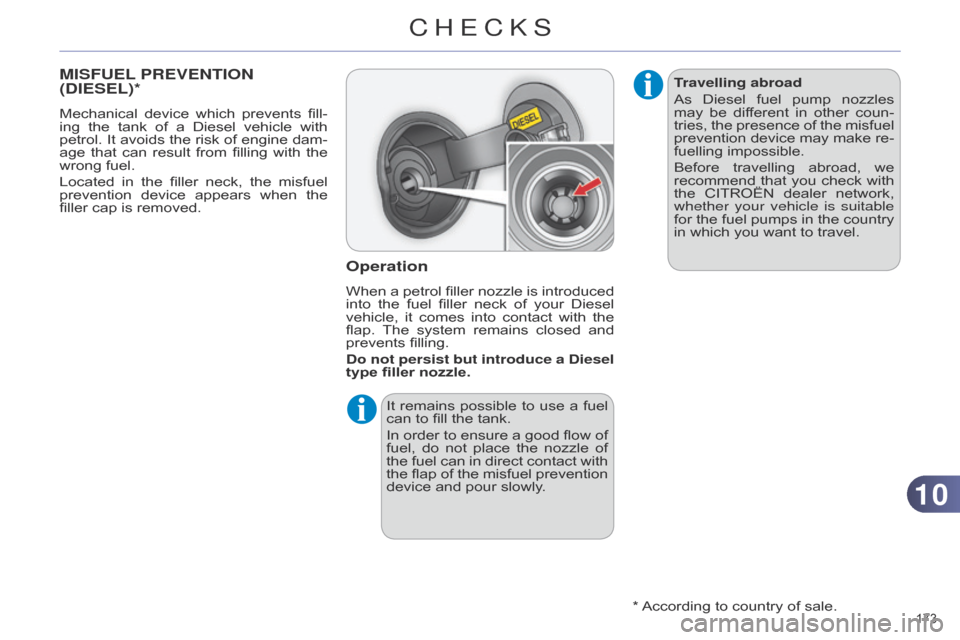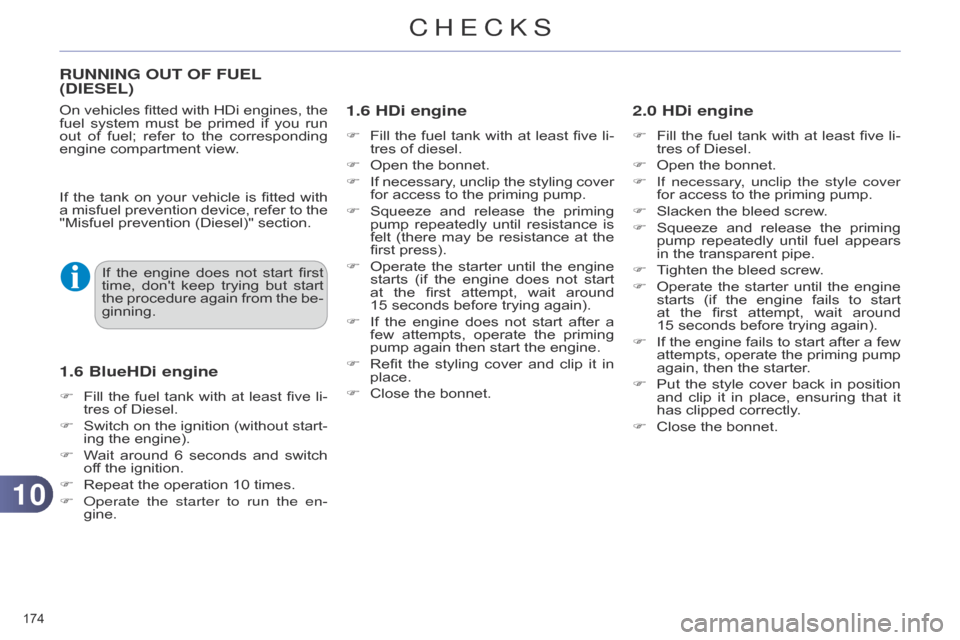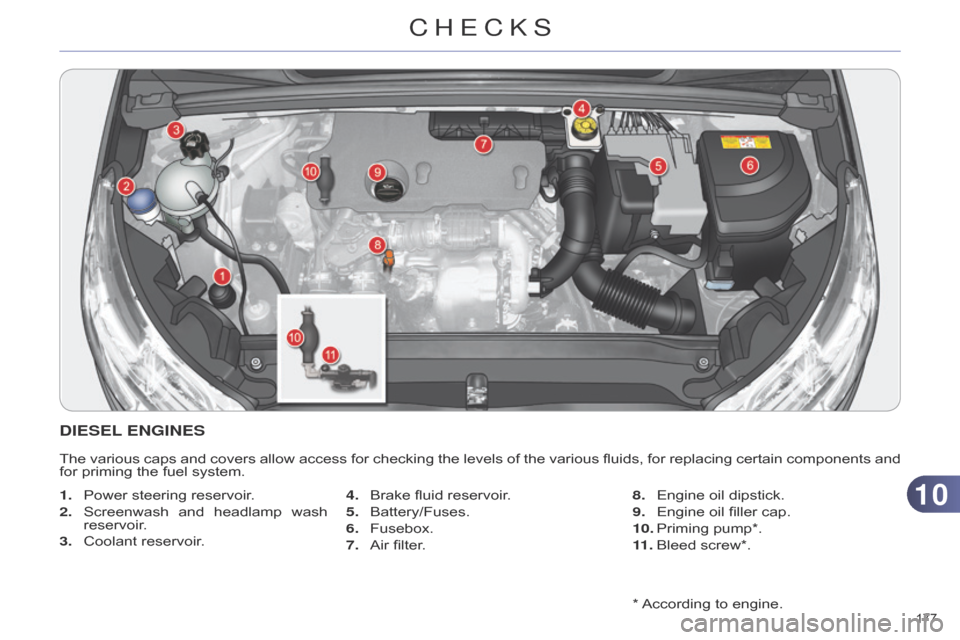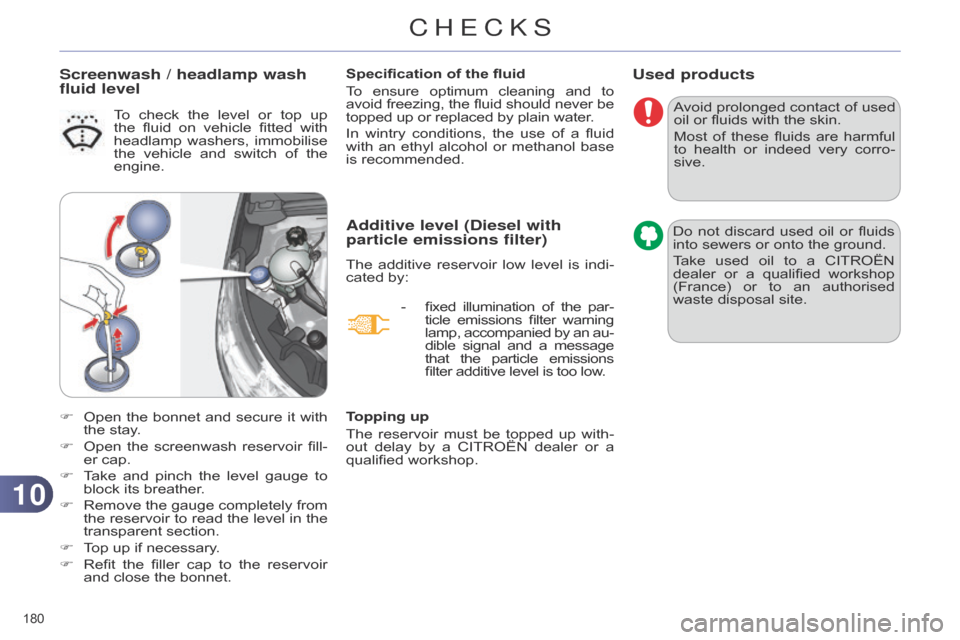check engine Citroen C4 DAG 2014.5 2.G Owner's Guide
[x] Cancel search | Manufacturer: CITROEN, Model Year: 2014.5, Model line: C4 DAG, Model: Citroen C4 DAG 2014.5 2.GPages: 340, PDF Size: 12.89 MB
Page 174 of 340

1010
172
C4-2_en_Chap10_verification_ed01-2014
Fuel used for petrol engines
The petrol engines are compatible with E10
bio-petrol (containing 10 % etha -
nol),
conforming
to
European
standards
EN
228 and EN 15376.
E85
type
fuels
(containing
up
to
85
%
ethanol)
are
reserved
exclusively
for
vehicles
marketed
for
the
use
of
this
type
of
fuel
(BioFlex
vehicles).
The
quality
of
the
ethanol
must
comply
with
European
standard EN 15293.
Fuel used for Diesel engines
The Diesel engines are compatible with biofuels
which conform to current and
future
European
standards
(Diesel
fuel
which
complies
with
standard
EN
590
mixed
with
a
biofuel
which
complies
with
standard
EN
14214)
available
at
the
pumps
(containing
up
to
7
%
Fatty
Acid
Methyl Ester).
The
B30
biofuel
can
be
used
in
cer
-
tain
Diesel
engines.
However
,
this
use,
even
occasional,
requires
strict
applica
-
tion
of
the
special
servicing
conditions.
Contact
a
CITROËN
dealer
or
a
quali
-
fied
workshop.
The use of any other type of (bio)fuel
(vegetable
or
animal
oils,
pure
or
dilu
t-
ed,
domestic
fuel...)
is
strictly
prohibited
(risk
of
damage
to
the
engine
and
fuel
system).
The
petrol
or
Diesel
engine
of
your
ve
-
hicle
is
fitted
with
a
catalytic
converter
,
a
device
which
helps
to
reduce
the
lev
-
el
of
harmful
emissions
in
the
exhaust
gases.
For petrol engines, the use of un
-
leaded fuel is compulsory.
The
filler
neck
is
narrower
,
admitting
unleaded
petrol
nozzles
only.
Fuel supply cut-off
Your vehicle is equipped with a safety device
which cuts of f the fuel supply in
the
event of a collision.
If you have put in the wrong
fuel for your vehicle, you must
have the tank drained and re-
filled with the correct fuel be-
fore you start the engine.
CHECKS
Page 175 of 340

1010
173
C4-2_en_Chap10_verification_ed01-2014
MISFUEL PREVENTION
(D IESEL )*
Mechanical device which prevents fill -
ing the tank of a Diesel vehicle with
petrol.
It
avoids
the
risk
of
engine
dam
-
age
that
can
result
from
fillin
g
with
the
wrong
fuel.
Located
in
the
filler
neck,
the
misfuel
prevention
device
appears
when
the
filler
cap is removed.
Operation
When a petrol filler nozzle is introduced into
the fuel filler neck of your Diesel
vehicle,
it
comes
into
contact
with
the
flap.
The
system
remains
closed
and
prevents
filling.
Do not persist but introduce a Diesel
type filler nozzle.
It
remains
possible
to
use
a
fuel
can
to fill the tank.
In
order
to
ensure
a
good
flow
of
fuel,
do
not
place
the
nozzle
of
the
fuel
can
in
direct
contact
with
the
flap
of
the
misfuel
prevention
device
and pour slowly.*
According
to country of sale.
Travelling abroad
As
Diesel
fuel
pump
nozzles
may
be
dif
ferent
in
other
coun
-
tries,
the
presence
of
the
misfuel
prevention
device
may
make
re
-
fuelling impossible.
Before
travelling
abroad,
we
recommend
that
you
check
with
the
CITROËN
dealer
network,
whether your vehicle is suitable
for
the
fuel
pumps
in
the
country
in
which you want to travel.
CHECKS
Page 176 of 340

1010
174
C4-2_en_Chap10_verification_ed01-2014
RUNNING OUT OF FUEL
(D IESEL )
1.6 HDi engine
F Fill the fuel tank with at least five li -
tres of diesel.
F
Open
the bonnet.
F
If
necessary
,
unclip
the
styling
cover
for
access to the priming pump.
F
Squeeze
and
release
the
priming
pump
repeatedly
until
resistance
is
felt
(there
may
be
resistance
at
the
first
press).
F
Operate
the
starter
until
the
engine
starts
(if
the
engine
does
not
start
at
the
first
attempt,
wait
around
15 seconds
before trying again).
F
If
the
engine
does
not
start
after
a
few
attempts,
operate
the
priming
pump
again then start the engine.
F
Refit
the
styling
cover
and
clip
it
in
place.
F
Close
the bonnet.
2.0 HDi engine
F Fill the fuel tank with at least five li -
tres of Diesel.
F
Open
the bonnet.
F
If necessary
, unclip the style cover
for
access to the priming pump.
F
Slacken
the bleed screw.
F
Squeeze
and
release
the
priming
pump
repeatedly
until
fuel
appears
in
the transparent pipe.
F
T
ighten the bleed screw.
F
Operate
the
starter
until
the
engine
starts
(if
the
engine
fails
to
start
at
the
first
attempt,
wait
around
15 seconds
before trying again).
F
If
the
engine
fails
to
start
after
a
few
attempts,
operate
the
priming
pump
again,
then the starter.
F
Put
the
style
cover
back
in
position
and
clip
it
in
place,
ensuring
that
it
has
clipped correctly.
F
Close
the bonnet.
If
the
engine
does
not
start
first
time,
don't
keep
trying
but
start
the
procedure
again
from
the
be
-
ginning.
On
vehicles
fitted
with
HDi
engines,
the
fuel
system
must
be
primed
if
you
run
out
of
fuel;
refer
to
the
corresponding
engine
compartment
view.
If
the
tank
on
your
vehicle
is
fitted
with
a
misfuel
prevention
device,
refer
to
the
"Misfuel
prevention
(Diesel)"
section.
1.6 BlueHDi engine
F Fill the fuel tank with at least five li -
tres of Diesel.
F
Switch
on
the
ignition
(without
start
-
ing
the engine).
F
W
ait
around
6
seconds
and
switch
of
f the ignition.
F
Repeat
the operation 10 times.
F
o perate the starter to run the en-
gine.
CHECKS
Page 177 of 340

1010
175
C4-2_en_Chap10_verification_ed01-2014
BONNET
F Push the exterior safety catch B to
the left and raise the bonnet.
Opening
F Open the front left door.
F
Pull
the interior bonnet release le-
ver
A,
located
at
the
bottom
of
the
door
aperture. F
Unclip
the
stay
C
from
its
housing
on
the back of the bonnet.
F
Fix
the
stay
in
the
notch
to
hold
the
bonnet
open.
The location of the interior bonnet
release
lever
prevents
opening
of the
bonnet
while
the
front
left
door is
closed.
Closing
F Take the stay out of the support notch.
F
Clip
the
stay
in
its
housing
on
the
back
of the bonnet.
F
Lower
the
bonnet
and
release
it
at
the
end of its travel.
F
Pull
on
the
bonnet
to
check
that
it
is
secured
correctly.
Do
not
open
the
bonnet
in
high
winds.
When
the
engine
is
hot,
handle
the
exterior
safety
catch
and
the
bonnet
stay
with
care
(risk
of
burns).
Before
doing
anything
under
the
bonnet, switch of
f the Stop &
Start
system
to
avoid
any
risk
of
injury
resulting
from
an
automatic change
to
START
mode.
The cooling fan may start after
switching off the engine: take care
with articles and clothing that might
be caught by the fan blades.
b
ecause of the presence of
electrical
equipment
under
the
bonnet,
it
is
recommended
that
exposure
to
water
(rain,
washing,
...) be limited.
CHECKS
Page 178 of 340

1010
176
C4-2_en_Chap10_verification_ed01-2014
PETROL ENGINES
The various caps and covers allow access for checking the levels of the various fluids and for replacing certain components.
1.
Power
steering reservoir.
2.
Screenwash
and
headlamp
wash
reservoir
.
3.
Coolant
reservoir. 4.
Brake
fluid reservoir.
5.
Battery/Fuses.
6.
Fusebox.7.
Air
filter.
8.
Engine
oil dipstick.
9.
Engine
oil filler cap.
CHECKS
Page 179 of 340

1010
177
C4-2_en_Chap10_verification_ed01-2014
* According to engine.
DIESEL ENGINES
The various caps and covers allow access for checking the levels of the various fluids, for replacing certain components and for
priming the fuel system.
1.
Power
steering reservoir.
2.
Screenwash
and
headlamp
wash
reservoir
.
3.
Coolant
reservoir. 4.
Brake
fluid reservoir.
5.
Battery/Fuses.
6.
Fusebox.
7.
Air
filter.8.
Engine
oil dipstick.
9.
Engine
oil filler cap.
10.
Priming
pump*.
11 .
Bleed
screw*.
CHECKS
Page 180 of 340

1010
178
C4-2_en_Chap10_verification_ed01-2014
CHECKING LEVELS
Take care when working under the bonnet, as certain areas of
the
engine
may
be
extremely
hot
(risk
of
burns)
and
the
cooling
fan
could
start
at
any
time
(even
with
the ignition off).
The
check
is
carried
out
either
when
the
ignition
is
switched
on
using
the
oil
level
indicator
in
the
instrument
panel
for
ve
-
hicles with an electric oil level
gauge,
or using the dipstick.
Engine oil level
Checking using the dipstick
Refer
to
the
"Petrol
engine"
or
"Diesel
engine"
section
for
the
location
of
the
dipstick
in
the
engine
compartment
of
your
vehicle.
F
T
ake
the
dipstick
by
its
coloured
grip
and
remove it completely.
F
Wipe
the
end
of
the
dipstick
using
a
clean
non-fluffy cloth.
F
Refit
the
dipstick
and
push
fully
down,
then
pull
it
out
again
to
make
the
visual
check:
the
correct
level
is
between
the marks A and B.
Check
all
of
these
levels
regularly
,
in
line
with
the
manufacturer's
service
schedule.
T
op
them
up
if
necessary
,
unless
otherwise
indicated.
If
a
level
drops
significantly
,
have
the
corresponding
system
checked
by
a
CITROËN
dealer
or
a
qualified
work
-
shop.
To
ensure
that
the
reading
is
correct,
your
vehicle
must
be
parked
on
a
level
surface
with
the
engine
having
been
of
f
for
more
than
30
minutes.
It
is
normal
to
top
up
the
oil
level
be
-
tween
two
services
(or
oil
changes).
CITROËN
recommends
that
you
check
the
level,
and
top
up
if
necessary
,
every
3
000
miles
(5
000
kms). A
= MAX
B
= MIN If
you find that the level is above the A
mark or below the B mark, do not start
the engine.
-
If
the
level
is
above
the
MAX
mark
(risk
of
damage
to
the
engine),
con
-
tact
a
CITROËN
dealer
or
a
quali
-
fied
workshop.
-
If
the
level
is
below
the
MIN
mark,
you
must top up the engine oil.
Oil grade
Before
topping-up
the
oil
or
changing
the
oil,
check
that
the
oil
is
the
correct
grade
for
your
engine
and
conforms
to
the
manufacturer's recommendations.
CHECKS
Page 181 of 340

1010
179
C4-2_en_Chap10_verification_ed01-2014
Brake fluid level
Changing the fluid
Refer
to
the
manufacturer's
service
schedule
for
details
of
the
interval
for
this
operation.
Fluid specification
The
brake
fluid
must
conform
to
the
manufacturer's
recommendations.
Power steering fluid level
The power steering fluid level should
be close to the "MAX" mark.
With
the
engine
cold,
un
-
screw
the
cap
to
check
the
level.
Coolant level
The coolant level should be close
to the "MAX" mark but
should
never exceed it.
When
the
engine
is
warm,
the
temperature
of
the
coolant
is
regulated
by
the
fan.
In
addition,
as
the
cooling
system
is
pressurised,
wait
at
least
one
hour
after
switching
of
f
the
engine
before
carrying
out
any
work.
To
avoid
any
risk
of
scalding,
unscrew
the cap by two turns to allow the pres
-
sure
to
drop.
When
the
pressure
has
dropped,
remove
the
cap
and
top
up
the
level.
Fluid specification
The
coolant
must
conform
to
the
manu
-
facturer's
recommendations.
The cooling fan may start after
switching off the engine: take
care with articles and clothing
that might be caught by the
fan blades.
The
brake
fluid
level
should
be
close
to
the
"MAX"
mark.
If
it
is
not,
check
the
brake
pad
wear.
Topping up the engine oil level
Refer
to
the
"Petrol
engine"
or
"Diesel
engine"
section
for
the
location
of
the
oil
filler
cap
in
the
engine
compartment
of
your
vehicle.
F
Unscrew
the
oil
filler
cap
to
reveal
the
filler
aperture.
F
Add
oil
in
small
quantities,
avoiding
any
spills
on
engine
components
(risk
of
fire).
F
W
ait
a
few
minutes
before
checking
the
level
again
using
the
dipstick.
F
Add
more
oil
if
necessary.
F
After
checking
the
level,
carefully
refit
the
oil
filler
cap
and
the
dipstick
in
its
tube.
After
topping
up
the
oil,
the
check
when
switching
on
the
ignition
with
the
oil
level
indicator
in
the
instrument
panel
is
not
valid
during
the
30
minutes
after
topping
up.
Engine oil change
Refer
to
the
manufacturer's
service
schedule
for
details
of
the
interval
for
this
operation.
In
order
to
maintain
the
reliability
of
the
engine
and
emission
control
system,
never
use
additives
in
the
engine
oil.
CHECKS
Page 182 of 340

1010
180
C4-2_en_Chap10_verification_ed01-2014
Used products
Avoid prolonged contact of used oil
or fluids with the skin.
Most
of
these
fluids
are
harmful
to
health
or
indeed
very
corro
-
sive.
Do
not
discard
used
oil
or
fluids
into
sewers or onto the ground.
Take
used
oil
to
a
CITROËN
dealer
or
a
qualified
workshop
(France)
or
to
an
authorised
waste
disposal site.
Additive level (Diesel with
particle emissions filter)
The additive reservoir low level is indi -
cated by:
Topping up
The
reservoir
must
be
topped
up
with
-
out
delay
by
a
CITROËN
dealer
or
a
qualified
workshop.
-
fixed
illumination
of
the
par
-
ticle
emissions
filter
warning lamp,
accompanied
by
an
au
-
dible
signal
and
a
message that
the
particle
emissions filter
additive level is too low.
Screenwash / headlamp wash
fluid levelSpecification of the fluid
To
ensure
optimum
cleaning
and
to avoid
freezing,
the
fluid
should
never
be topped
up or replaced by plain water.
In
wintry
conditions,
the
use
of
a
fluid
with
an
ethyl
alcohol
or
methanol
base
is
recommended.
To
check
the
level
or
top
up
the
fluid
on
vehicle
fitted
with
headlamp
washers,
immobilise
the
vehicle
and
switch
of
the
engine.
F
Open
the
bonnet
and
secure
it
with
the
stay.
F
Open
the
screenwash
reservoir
fill
-
er
cap.
F
T
ake
and
pinch
the
level
gauge
to
block
its
breather.
F
Remove
the
gauge
completely
from
the
reservoir
to
read
the
level
in
the
transparent
section.
F
T
op
up
if
necessary.
F
Refit
the
filler
cap
to
the
reservoir
and
close
the
bonnet.
CHECKS
Page 183 of 340

1010
181
C4-2_en_Chap10_verification_ed01-2014
CHECKSParticle emission filter (Diesel)
The start of saturation of the particle
emissions filter is indicated by:
-
fixed
illumination
of
the
par
-
ticle
emissions
filter
warning lamp,
accompanied
by
an audible
signal
and
a
message that
there
is
a
risk
of
blockage of
the particle emissions filter.
The presence of this label, in particular
with
the
Stop
&
Start
system,
indicates
the
use
of
a
specific
12
V
lead-acid
bat
-
tery
with
special
technology
and
specifi
-
cation.
The
involvement
of
a
CITROËN
dealer
or
a
qualified
workshop
is
essen
-
tial
when
replacing
or
disconnecting
the
battery
. On
a
new
vehicle,
the
first
op
-
erations
of
regeneration
of
the
particle
emissions
filter
may
be
accompanied
by
the
smell
of
"burning",
which
is
perfectly
nor
-
mal.
Following
prolonged
operation
of
the
vehicle
at
very
low
speed
or
at
idle,
you
may
,
in
excep
-
tional
circumstances,
notice
the
emission
of
water
vapour
at
the
exhaust
on
acceleration.
This
does
not
af
fect
the
behaviour
of
the
vehicle or the environment.
As
soon
as
the
traffic
conditions
per
-
mit,
regenerate
the
filter
by
driving
at
a
speed
of
at
least
40
mph
(60
km/h)
until
the
warning lamp goes off.
If
the
warning
lamp
stays
on,
refer
to
the
"Additive level" section.
Unless
otherwise
indicated,
check
these
components
in
accordance
with
the
manufacturer's
service
schedule
and
according
to
your
engine.
Otherwise,
have
them
checked
by
a
CITROËN
dealer
or
a
qualified
work
-
shop.
Air filter and passenger compartment filter
Refer to the manufacturer's service
schedule for details of
the
replacement
intervals
for
these
components.
Depending
on
the
environ
-
ment
(e.g.
dusty
atmosphere)
and
the
use
of
the
vehicle
(e.g.
city
driving),
re
-
place them twice as often if neces-
sary.
A
clogged
passenger
compartment
fil
-
ter
may
have
an
adverse
ef
fect
on
the
performance
of
the
air
conditioning
sys
-
tem
and
generate undesirable odours.
Oil filter
Replace the oil filter each time the
engine oil is changed.
Refer
to
the
manufacturer's
service
schedule
for
details
of
the
replacement
interval
for
this
component.
12 V battery
The battery does not require any
maintenance.
However,
check
that
the
ter
-
minals
are
clean
and
correctly
tightened,
particularly
in
sum
-
mer
and
winter.
When
carrying
out
work
on
the
battery
,
refer
to
the
"12
V
battery"
section
for
details
of
the
precautions
to
be
taken
before
disconnecting
the
battery
and
following
its reconnection.
CHECKS